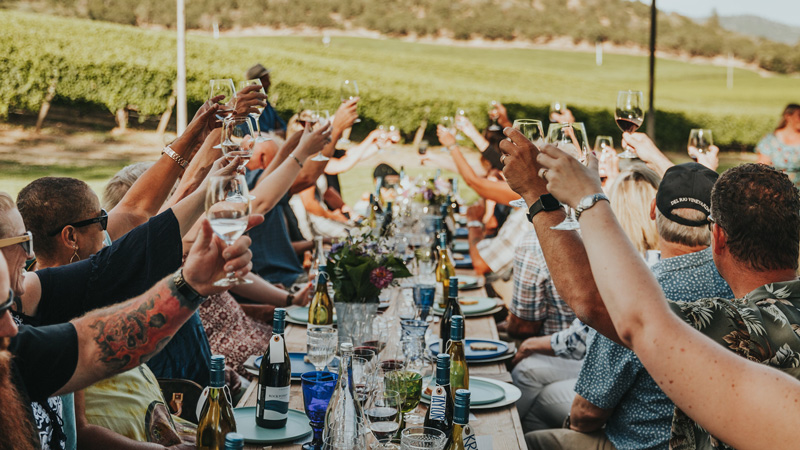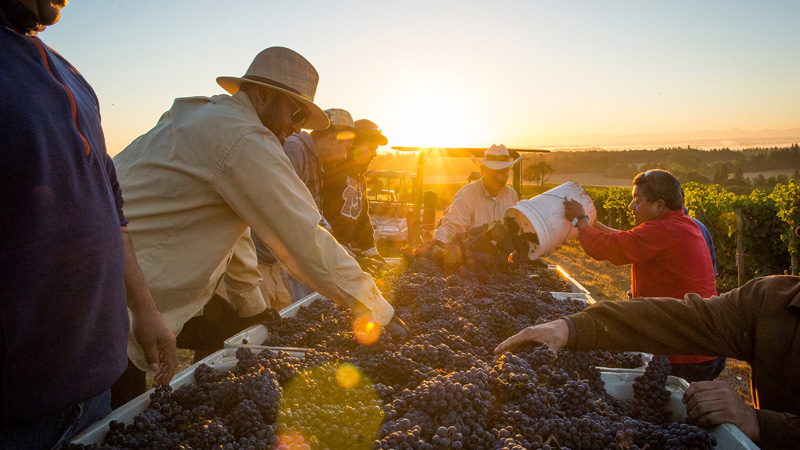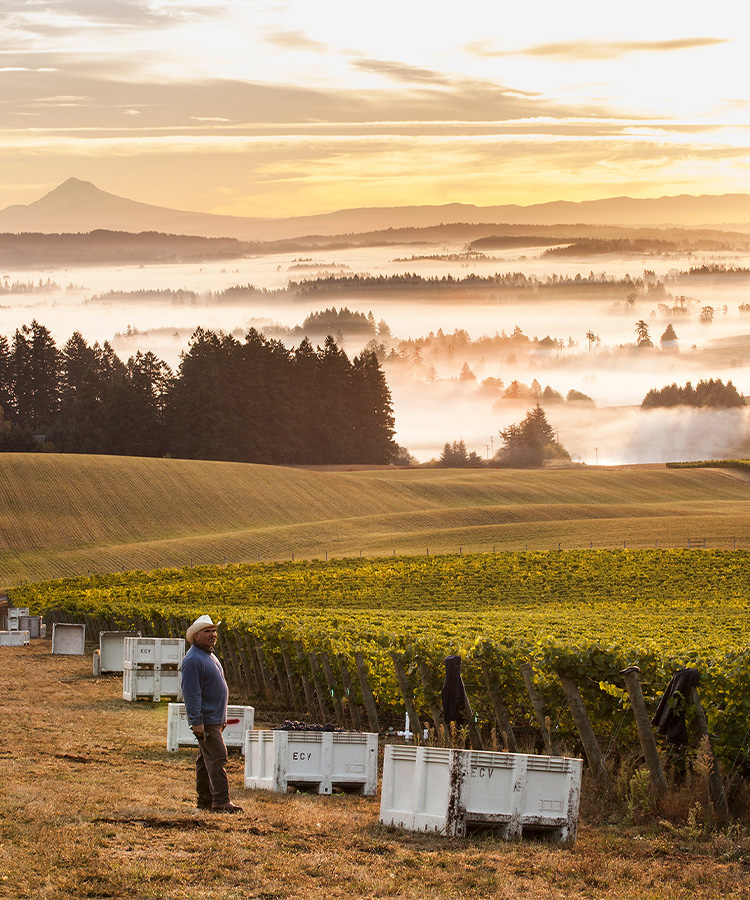
May is Oregon Wine Month, and it’s a perfect time of year to explore the Pacific Northwest state, either in person or through your palate. While Oregon has long been a darling among Pinot Noir fans, this versatile state produces so much more, from effervescent bubblies to full-bodied Syrahs, often made from biodynamically grown grapes at small, family-run wineries. Oregon’s rich agricultural traditions mean that restaurants across the state have easy access to fresh, flavorful produce, making the state a destination for chefs and culinary travelers alike.

Whether you’re planning a wine-tasting trip through Oregon or want to stock your cellar with some of the most delectable wines grown in the U.S., here’s everything you need to know about Oregon’s wines and regions.
Portland
Oregon’s largest city is where many wine adventures begin in the state, and despite the urban environs, Portland is very much a haven for wine lovers. Many celebrated Willamette Valley wineries — including Fullerton Wines and Erath Winery — have tasting rooms right in the heart of town, and the city has dozens of homegrown urban wineries that source their grapes from across the Pacific Northwest.
The oldest of these, Hip Chicks Do Wine, opened their first tasting room in 2001, paving the way for dozens more to follow in their footsteps. These days, you can pair Pinot with a DIY charcuterie board at Boedecker Cellars in the Northwest Industrial District or head over to Southeast Portland’s Teutonic Wine Company to sample German and Alsatian-style wines made with Oregon fruit.
For a more sylvan experience, go to Amaterra Winery in Portland’s West Hills, where you can pair wine with vineyard views — without leaving the city limits. Come for the wine and stay for the food: Portland is internationally renowned for its robust dining scene and is home to award-winning restaurants such as celebrity chef Gregory Gourdet’s kann.
The Columbia Gorge
A short drive east of Portland takes you to the Columbia Gorge, an enchanting area known for its gorgeous wines, magnificent forests, and towering waterfalls. What makes this region special is its transitional climate, which has a distinctly cooler and rainier climate in the west and a drier, high-desert climate on the eastern end of the Cascade Mountains. The region’s vineyards can produce a huge range of varietals, including grapes such as Cabernet Sauvignon and Syrah, which typically fare better in warmer conditions.
Much of the activity in the region centers around its bigger communities, such as Hood River, where you can dine on dishes crafted with locally farmed and raised ingredients at Hiyu Wine Farm. Or try biodynamic Tinto and Mencia at Analemma in nearby Mosier. If you keep heading east, you’ll eventually make it to The Dalles, where you can try port-style wine and Barbera at 15 Mile Winery or have your wine with a dose of history at Sunshine Mill, housed in an old flour mill, which was originally run by the Sunshine Biscuit Company (of cheesy square cracker fame).
The Walla Walla Valley
If you continue east along the Columbia River, you’ll eventually land up in the Walla Walla Valley, which straddles the Oregon-Washington border. On the Washington side sits the city of Walla Walla, where many of the region’s tasting rooms and restaurants are located, but much of the region’s grapes are actually grown in Oregon. This area is notable for its unusual soil, composed of sand, silt, and volcanic basalt cobbles that collectively create ideal conditions for vines to root deeply. Warmer temperatures and low rainfall create prime conditions for growing celebration-worthy Syrahs, Cabs, and Merlots.
The Willamette Valley
It’s no surprise that the Willamette Valley is the region that most people think of when they consider Oregon wine. It’s the state’s oldest wine region and the largest, accounting for around two-thirds of Oregon’s wineries and vineyards. Stretching from Portland clear down to Eugene, the AVA is massive, with around 25,450 planted acres and 11 sub-AVAs. The region’s cool, sometimes sunny climate and mineral-rich soils make it ideal for growing not only Oregon’s beloved Pinot and Chardonnay but also Gewürztraminer, Riesling, and even Gamay.
The Willamette Valley is among the most popular destinations for wine-tasting adventures, and its hilltop wineries and quaint towns are within an easy drive of Portland. Wine tourism here centers around cities such as Newberg, Dundee, and McMinnville, where even the mayor herself, Remy Drabkin, is a winemaker. Many Willamette Valley wineries take sustainable and alternative approaches to winemaking. Sip biodynamic wine at much-lauded spots such as Maysara Winery in McMinnville or Brooks Wine in Amity, both multigenerational family-run wineries, or head further south to Junction City’s Antiquum Farm — also a family venture — to learn about their grazing-based approach to viticulture.
The Umpqua Valley
Southern Oregon’s Umpqua Valley is among the state’s most versatile wine regions, with a cool climate similar to the adjacent Willamette Valley in the northern parts and a central transitional zone ideal for all sorts of grapes. As you continue south, you move into warm varietal territory, making for some excellent Syrah, Merlot, and Tempranillo. Though Oregon’s first vineyard was planted in Jacksonville in the 1880s, it wasn’t until 1961 when winemaker Richard Sommer planted the state’s first Pinot Noir vines, establishing family–owned HillCrest Winery and laying the foundation for the future of Oregon wine. Many of the region’s tasting rooms are around the Umpqua Valley’s largest city, Roseburg, and in the small mountain town of Elkton, which looks out over the Umpqua River.
The Rogue Valley
Oregon’s southernmost wine region is equally suited for grapes that thrive in both cooler and warmer climates, with three mild microclimates and contrastingly warm days and cool nights that lend themselves to a slow ripening season. The result? A beautiful, sunny region that produces some of Oregon’s tastiest — and certainly most balanced — wines. Wine-tasting experiences in the Rogue Valley center in the pastoral outskirts of Ashland, a hub for Shakespearean theater in the U.S., nearby Talent, a cozy town on the rise, and Jacksonville, an adorable historic town dotted with wineries, which is considered the birthplace of Oregon wine having the first documented winery in 1882.
Biodynamic wine has a solid presence in the Rogue Valley, and some of the region’s most acclaimed wineries are Demeter-certified. Two of these producers are located in the Applegate Valley sub-AVA and include the aptly named Cowhorn Vineyard & Garden, a nature-focused riverfront property offering everything from Marsanne and Roussanne blends to Viognier and Syrah. Try them alone or pair them with pizza made from organically farmed ingredients. Troon Vineyard & Farm is both Demeter Biodynamic and Regenerative Organic Gold Certified, producing everything from amphorae-aged Vermentino and Mourvèdre to silky Tannat brought into its full potential via whole-cluster fermentation.

Ready to experience Oregon’s wine country for yourself? May kicks off prime wine-tasting season, with beautiful weather (and just a little rain) from late spring into early fall. Learn more about Oregon’s wines and its wine regions at oregonwine.org.
This article is sponsored by the Oregon Wine Board.
